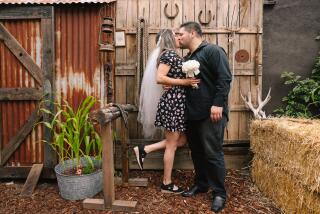Marriage Lasts Forever in Gretna Green
- Share via
GRETNA GREEN, Scotland — A young man in a kilt shushes the assembled tourists as the bride and groom join hands over an anvil in a re-created blacksmith shop that looks like a set from an old Western.
Just down the road, at another re-created blacksmith, one set of newlyweds politely steps aside to allow another wedding couple to make their way to the anvil.
On the leafy grounds of the adjacent hotel, a photographer poses another pair in full wedding regalia. And over at the registry office, couples are lined up to tie the knot.
In Gretna Green, weddings aren’t just a tradition; they’re an industry.
Thanks to the Scottish border town’s colorful history as a destination for eloping English couples, people now come from all over the world to get married, outfitted in everything from kilts and motorcycle leathers to the poshest of tuxedos and designer gowns.
Last year, Gretna Green played host to 4,457 weddings--that’s about 12 a day, every day of the year, in a district with just 3,000 or so residents. This August, ceremonies were held at a rate of about 23 a day.
Some couples go for a traditional but not very intimate ceremony over the anvil in the World Famous Blacksmith Shop Centre museum, which is one of Scotland’s top tourist destinations.
But most opt for the modern registry office or someplace else where strangers aren’t stopping for a look.
“Here it’s very much like a carnival, but we loved it,” said 32-year-old Marcel Andriessen, who gleefully posed for pictures with tourists moments after marrying Judith Frieda Siebelink, 33, in the private wedding room at the blacksmith shop.
The Dutch couple had vacationed in the stunning green hills of Scotland last year and decided to come back to get married. They discovered Gretna Green and its legend via the Internet, and obviously didn’t mind the camera-toting vacationers, who arrive by the busload.
In the Gretna Green of yesteryear, young couples arriving to be wed were more than likely in a big hurry.
A law passed by Britain’s Parliament in 1754 required all marriages in England to be recognized by the church, and couples under 21 to have parental consent. Scotland, however, still allowed people 16 and older to wed just by having their marriage proclaimed in front of two witnesses.
Teenagers in love would hitch up a pair of fast horses and head for Scotland, often with furious and heavily armed parents in pursuit.
By virtue of being the first town across the border on the main road, Gretna Green became a logical spot for hasty nuptials. A blacksmith shop was among the cluster of buildings there, so “anvil weddings” became a tradition, the sharp clang of a hammer on forged metal sealing the union.
“It’s like the estate agents say-- location, location, location,” said Alasdair Houston, whose family has owned the original blacksmith shop for four generations and opened it to the touring public in 1886.
Lots of folks forged a living as “anvil priests” until a law passed in 1940 decreed that only a clergyman or registrar could conduct a wedding.
That put an end to elopements to Gretna Green, although a trickle of people still came to be wed at the place immortalized in the Jane Austen novel “Pride and Prejudice” and forever regarded as the most romantic spot in Britain.
Ceremonies dwindled to just a few dozen a year in the 1970s, but then came a wave of new publicity about Gretna Green’s history and the opening of a new registry office building outfitted with spacious wedding suites.
The number of yearly marriages jumped to a few hundred in the ‘80s and soared to the thousands in the ‘90s.
The town got another boost in 1995, when the law in England was changed to allow couples to be married in locales other than a church or registrar’s office for the first time since 1837. That started engaged English couples looking for alternative sites, including Gretna Green, where characters on the top British TV soap operas always seem to go for their clandestine weddings.
This year is on track to be the town’s biggest wedding tear ever, Registrar Alison Quigley said.
So why do people come?
“Because they’ve been coming here for 250 years,” said Jim Jackson, the kilted “anvil priest” at the Gretna Hall Hotel’s blacksmith shop. “People want to be part of the legend.”
Not being a clergyman, Jackson cannot marry people. But in 15 years he has performed 30,000 “blessings of tradition” over the anvil, often for couples who come straight from their legal ceremony in the registry office.
Weddings are without question the major business in Gretna Green. Half the storefronts on the modest main street are inhabited by photographers, hairdressers, bagpipers-for-hire and the like.
Area hotels, bed-and-breakfast inns and even medieval castles have gotten in on the act, but the centerpiece remains the World Famous Blacksmith Shop Centre, delightfully kitschy with its resident bagpiper, cafeteria and huge souvenir shop specializing in Scottish tartans.
More than 700,000 people visited last year, making it the second biggest tourist attraction in Scotland after Edinburgh Castle.
Houston, the managing director, insisted the sometimes unwieldy mix of tourists and weddings--around 1,000 will be conducted there this year--is a happy one.
“The great thing about the weddings is you have visitors from all over the world,” he said. “For them to see a couple arriving on their wedding day, it is a powerful moment for all concerned.”
More to Read
Sign up for The Wild
We’ll help you find the best places to hike, bike and run, as well as the perfect silent spots for meditation and yoga.
You may occasionally receive promotional content from the Los Angeles Times.




